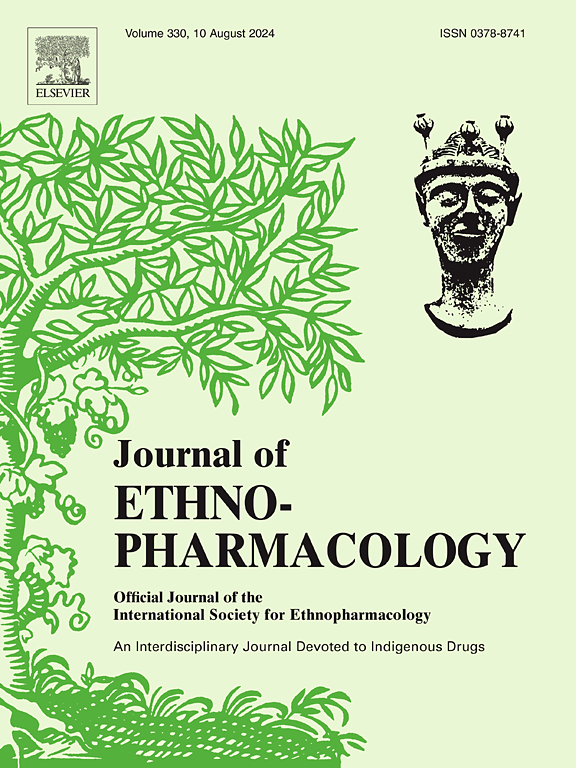Qingfei Litan decoction alleviated Klebsiella pneumoniae-induced pneumonia by targeting the TLR4/MyD88/NF-κB axis via miR-146a-5p
IF 4.8
2区 医学
Q1 CHEMISTRY, MEDICINAL
引用次数: 0
Abstract
Ethnopharmacological relevance
Klebsiella pneumoniae (Kp) is a significant pathogen responsible for various clinical bacterial infections, including pneumonia, sepsis, and even death. However, effective treatment options remain limited due to the rising prevalence of antimicrobial resistance. Traditional Chinese medicine (TCM) has shown potential in the treatment of bacterial pneumonia. Qingfei Litan decoction (QFLT) has been reported to alleviate symptoms in patients with bacterial pneumonia, though its precise mechanisms in regulating pulmonary inflammation remain unclear.
Aim of the study
This study aimed to investigate the therapeutic potential of QFLT in Kp-induced pneumonia and to elucidate its underlying molecular mechanisms.
Material and methods
In vivo, a murine pneumonia model was established through intratracheal instillation of Kp, and QFLT was administered by oral gavage. miR-146a-5p expression was downregulated by tail vein injection of an antagomir. The therapeutic effects of QFLT on pulmonary pathology, inflammatory factors, and miR-146a-5p expression were evaluated using qRT-PCR, flow cytometry, and other methods. Bioinformatics tools were employed to predict miR-146a-5p targets and associated inflammatory pathways. In vitro, an alveolar macrophage inflammation model was established by stimulating MH-S cells with heat-inactivated Klebsiella pneumoniae (iKp), followed by QFLT treatment. Inhibition of miR-146a-5p was achieved through transfection with specific inhibitors. The effects of QFLT on inflammatory responses, miR-146a-5p expression, and TLR4/MyD88/NF-κB signaling were assessed using qRT-PCR, Western blotting (WB) and other methods.
Results
Kp infection significantly exacerbated pulmonary inflammation and downregulated miR-146a-5p expression in both lung tissues and MH-S cells. QFLT treatment alleviated inflammatory responses and upregulated miR-146a-5p expression. Bioinformatics analysis demonstrated that miR-146a-5p targeted TRAF6, a key mediator of the TLR4/MyD88/NF-κB pathway. Western blot analysis further confirmed that QFLT reduced Kp-induced upregulation of the TLR4/MyD88/NF-κB pathway in MH-S cells. Moreover, inhibition of miR-146a-5p exacerbated inflammatory responses in both lung tissues and MH-S cells, whereas QFLT treatment effectively attenuated these inflammatory effects. Furthermore, miR-146a-5p suppression resulted in elevated expression of proteins in the TLR4/MyD88/NF-κB signaling pathway in MH-S cells, while QFLT administration significantly reduced the expression levels of these signaling components.
Conclusions
These findings demonstrated that QFLT ameliorated Kp-induced pneumonia by modulating the TLR4/MyD88/NF-κB axis via miR-146a-5p.
清肺理痰汤通过miR-146a-5p靶向TLR4/MyD88/NF-κB轴缓解肺炎克雷伯菌所致肺炎。
民族药理学相关性:肺炎克雷伯菌(Kp)是一种重要的病原体,可导致各种临床细菌感染,包括肺炎、败血症甚至死亡。然而,由于抗菌素耐药性日益普遍,有效的治疗选择仍然有限。中医在治疗细菌性肺炎方面显示出潜力。据报道,清肺理痰汤(QFLT)可缓解细菌性肺炎患者的症状,但其调节肺部炎症的确切机制尚不清楚。研究目的:本研究旨在探讨QFLT对kp性肺炎的治疗潜力,并阐明其潜在的分子机制。材料与方法:在体内,通过气管内滴注Kp建立小鼠肺炎模型,QFLT灌胃给药。通过尾静脉注射安他戈莫下调miR-146a-5p的表达。采用qRT-PCR、流式细胞术等方法评估QFLT对肺部病理、炎症因子和miR-146a-5p表达的治疗作用。采用生物信息学工具预测miR-146a-5p靶点和相关炎症途径。体外用热灭活肺炎克雷伯菌(Klebsiella pneumoniae, iip)刺激h - s细胞,再加QFLT治疗,建立肺泡巨噬细胞炎症模型。通过转染特异性抑制剂实现miR-146a-5p的抑制。采用qRT-PCR、Western blotting (WB)等方法评估QFLT对炎症反应、miR-146a-5p表达、TLR4/MyD88/NF-κB信号传导的影响。结果:Kp感染显著加重肺部炎症,降低肺组织和MH-S细胞中miR-146a-5p的表达。QFLT治疗可减轻炎症反应并上调miR-146a-5p的表达。生物信息学分析表明,miR-146a-5p靶向TLR4/MyD88/NF-κB通路的关键介质TRAF6。Western blot分析进一步证实,QFLT降低了kp诱导的MH-S细胞中TLR4/MyD88/NF-κB通路的上调。此外,抑制miR-146a-5p加剧了肺组织和MH-S细胞的炎症反应,而QFLT治疗有效地减弱了这些炎症反应。此外,miR-146a-5p抑制导致MH-S细胞中TLR4/MyD88/NF-κB信号通路蛋白表达升高,而QFLT处理显著降低了这些信号组分的表达水平。结论:这些研究结果表明,QFLT通过miR-146a-5p调节TLR4/MyD88/NF-κB轴来改善kp诱导的肺炎。
本文章由计算机程序翻译,如有差异,请以英文原文为准。
求助全文
约1分钟内获得全文
求助全文
来源期刊

Journal of ethnopharmacology
医学-全科医学与补充医学
CiteScore
10.30
自引率
5.60%
发文量
967
审稿时长
77 days
期刊介绍:
The Journal of Ethnopharmacology is dedicated to the exchange of information and understandings about people''s use of plants, fungi, animals, microorganisms and minerals and their biological and pharmacological effects based on the principles established through international conventions. Early people confronted with illness and disease, discovered a wealth of useful therapeutic agents in the plant and animal kingdoms. The empirical knowledge of these medicinal substances and their toxic potential was passed on by oral tradition and sometimes recorded in herbals and other texts on materia medica. Many valuable drugs of today (e.g., atropine, ephedrine, tubocurarine, digoxin, reserpine) came into use through the study of indigenous remedies. Chemists continue to use plant-derived drugs (e.g., morphine, taxol, physostigmine, quinidine, emetine) as prototypes in their attempts to develop more effective and less toxic medicinals.
 求助内容:
求助内容: 应助结果提醒方式:
应助结果提醒方式:


